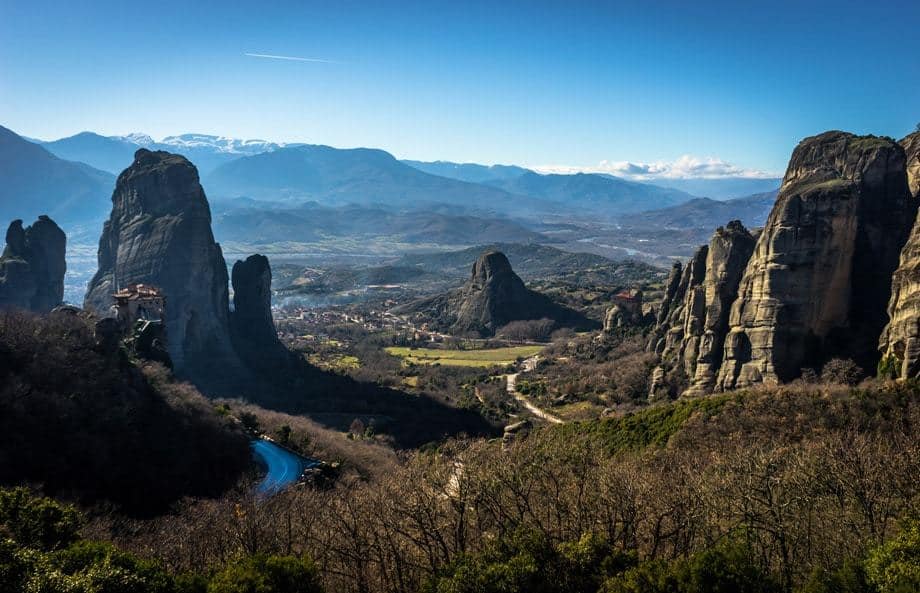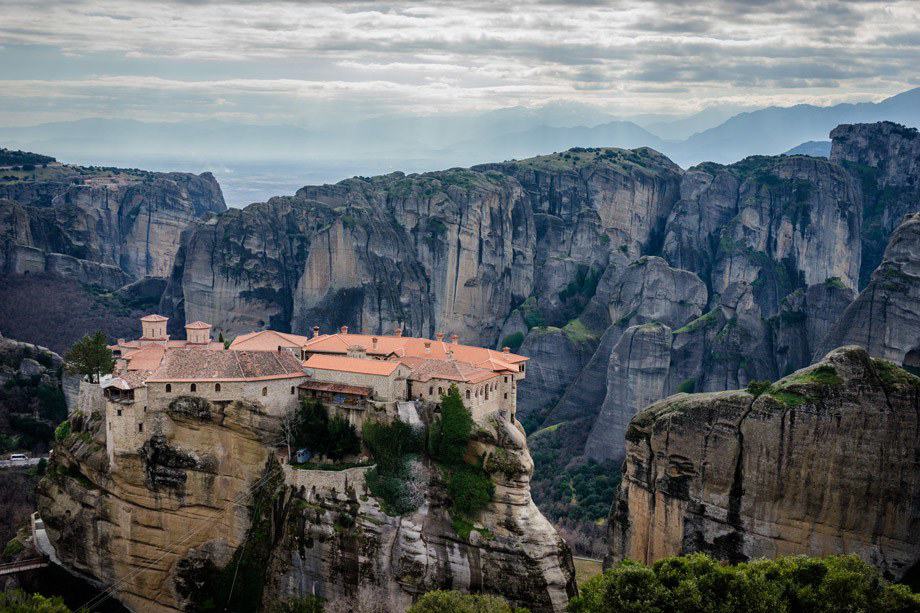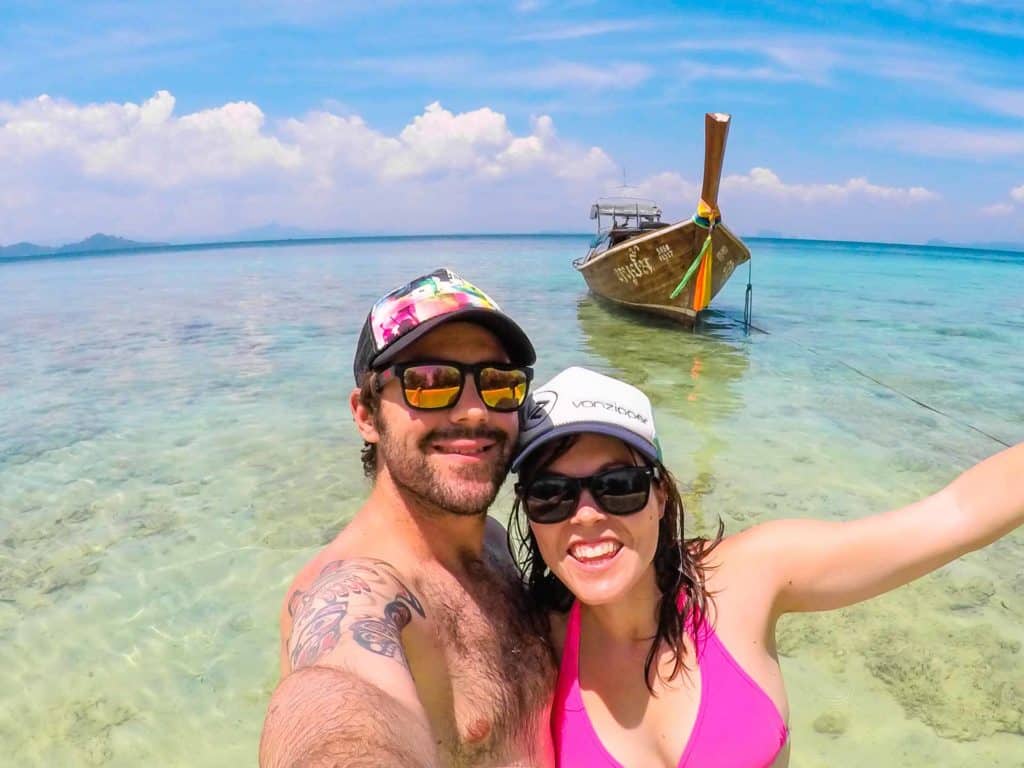
During the archaic times of 11th century Europe, political turmoil was ravaging Greece. Warriors from Constantinople were pushing into the West, clashing with fighters who were trying to sustain their own strongholds. Hermits were struggling to maintain their ascetic belief system, being persecuted as they drifted from one village to the next. With nowhere to hide, they began to look to the Heavens for safety. They saught solace in the peaks above them, and the first monasteries of Meteora began to take shape.
When Athanasios Koinovitis arrived in the small village in the 14th century, surrounded by sandstone monoliths, his upward gaze was rewarded with an idea. Inspired by the hermits perched in the caves above, he decided to migrate his devout worshippers to Meteora, and unknowingly created one of the most spectacular religious centres on the planet.
The monasteries of Meteora are perhaps some of the most photographed icons in all of Europe. The stone, brick and timber places of worship sit harmoniously on the summits of various peaks around the villages of Kastraki and Kalambaka, blending seamlessly into their foundations.
How they were built is a modern-day marvel.


When Athanasios Koinovitis first arrived in Meteora, he admired the hermits of the area, who would free-climb the vertical cliffs to seek refuge in crevices and caves. Envisioning these peaks as a place where his people could meditate and practice their religion in peace, he employed the hermits to teach him how to climb.
Over the next two centuries, the monks would ascend the crags, building pulley systems to help carry building materials to the top. What they created were 24 stupendous monasteries that allowed isolation from the warring tribes below them. Today only six remain, but their captivating positions still take people’s breath away.
Having spent five days in Athens, the energetic Greek capital, it was time for us to board a train and head to Kalambaka. At the end of two years crossing Asia, following the Silk Road and traversing a dizzying array of landscapes and religious centres, we were ready to see the best of what Europe has to offer.

As the train rounded a bend we caught our first glimpse of the towering monasteries, and were instantly impressed. Even from the ground, there was no denying the imposing beauty of these mountaintop refuges. We couldn’t get off the train quick enough.
We walked to the office of Visit Meteora, who would be our hosts for the next four days. The managing director, George, sat us down and beamed with excitement as he talked about his hometown. He was careful not to give too much information away, however, as he was to be leading us on a guided tour the following day.
Jumping in a van, their driver gave us a brief tour of the area, before dropping us off at the Grand Meteora Hotel in Kastraki village – a brand-new, 4-star complex that had just been completed a few months before our arrival. We checked in and were surprised to discover that we were the only guests in the entire facility. We had heard that Meteora was quiet in the off-season, but we never expected this.


Walking around Kastraki we realised just how empty the village was. We were the only tourists around. Restaurants were closed, supermarkets were boarded up, and we had the streets to ourselves. Helpful locals pointed us in the direction of Tavern Ouzeri Pappas, the only restaurant that was still open, and we feasted on souvlaki and red wine before retiring for the night.
At 9am we were met by George and one other lady who would be with us on the Hiking Tour Of Meteora. We were dropped at a trailhead, at the base of a mountain, with the Pantokrator Monastery perched proudly above. George walked us to an empty field and began his introduction to the area.
The history of Meteora is well-known – the monks that moved to the area and built the monasteries to escape persecution and war, and thus created a marvel of architecture. But it is the unknown tales that George bestowed upon us, and the ones that most intrigued us. Some were controversial, and we were asked specifically not to write about it. You will have to meet with him yourself if you wish to know the secret stories of Meteora.

The trail led us around the sandstone and conglomerate rocks, and through a picturesque forest. In summer the heat can be almost unbearable, but on this day in January it was balmy and cool. Soon we pulled up at the bottom of the Ypapanti Monastery, which is closed to the public almost year-round. George told us stories of how it came to be in existence, and then revealed that it opens to the masses only one day a year. That day happened to be the following week, but alas we would be back on the road in Turkey by then. Another reason to prepare a second visit to Meteora.

Climbing the dusty trail, we reached a statue of a famous Greek historian. Here George revealed his true passion of his country, and regaled us with historic tales and in-depth insights into the evolution and creation of modern-day Greece. No amount of history reading can match the details given from an educated and passionate local, and we appreciated George’s honesty.
By now we had found ourselves near the top of the mountains, and a short walk revealed the glorious views that Meteora is most recognised for – that of the peaks and monasteries that adorn them.

Once we had made the most of the photo opportunities, we walked down towards the Great Meteoron Monastery, the largest and most famous of all in Meteora. For centuries the only way inside was to climb the cliffs or be lifted by a rope and pulley system. Today a bridge and staircase has been carved for visitors, and a cable car connects the nearby hill to the peak, allowing the monks to access the monastery easier.
The girls were required to wear a skirt to enter, and the monastery provides them with the cost of entry (only 3 Euro). George then took us on a vibrant and enthusiastic tour of the grounds, pointing out the ancient tools stashed away, and offering stories and history in the fascinating museum. We tryed to decipher millennia-old parchments and admired original costumes. The museum alone is worth more than the price of admission.
Once we had explored the grounds, it was time to descend the mountain. This trail was steeper than the previous one, and we were glad George had planned the tour to finish downhill. Our driver was waiting to pick us up when we arrived, and he happily dropped us at the Grand Meteora Hotel. We thanked George for the amazing experience, and he informed us we still had more planned for the next day.
Resting up and enjoying a glass of wine, we waited the night out in the quiet serenity of Kastraki village.

The following morning we were taken on the iconic Meteora Half-Day Driving Tour, that would take us to two of the monasteries we had missed, and out to the prehistoric Theopetra Cave.
We stopped by the monasteries of Varlaam and St Stephen’s, and were allowed to wander freely. Each monastery offers a fascinating view and intriguing history, and we could easily have spent hours in each one.
But the highlight of the tour was the Theopetra Cave. Situated 15 minutes from the village of Kalambaka, the Theopetra cave is nestled high in a mountain, overlooking an important trade route. The Lithaios River flows at the foot of the cave, meaning the inhabitants always had access to fresh drinking water. The importance of this location was realised at an early time.

Radiocarbon dating finds that artefacts and remnants of human existence in the cave goes back over 50’000 years. An elevated boardwalk has been built to allow visitors access without causing any harm to the phenomenal history that lies inside. We marvelled at the millennia-old footprints still resting in the crusted mud. Afterwards, we wandered through the halls of the superb museum that holds some of the best-preserved archaeological finds. Spanning both the times of the neanderthal and modern-day humans, the historical significance of this cave is astounding.
We returned to Kalambaka with a newfound appreciation of the monasteries and history of Meteora. The next day we took part in the scrambling and via ferrata tour of the Great Saint, which helped further cement this place as one of the most striking and exciting destinations we had visited in recent times.

Sitting back at our hotel, with another glass of wine in hand, we stared up at the timeless monasteries above. With a pristine sky shimmering and light bouncing off the sandstone monoliths, it was easy to lose ourselves in the intense beauty Meteora has to offer. Few places deserve as much recognition as this epic region, nestled in the mountains of Central Greece.
We were welcomed as guests of Visit Meteora for our day tours in the area. The Grand Hotel also hosted us during our stay. All thoughts and opinions are of course, our own.



4 thoughts on “Lost In Time – Hiking The Monasteries Of Meteora”
Awesome blog. Wandered in as I was looking for info on the monasteries – we leave in 3 weeks for our visit. Plan to go back and read more about your adventures… we love to travel as well. Greece will make country 57!
Ancient monasteries, Hermits, The Silk Road, archaeological Mysteries, and a local guy with secret stories of the past. This is just the kind of thing I love! Wonderful post.
That’s a wonderful post, truly enjoyed this one.
Thanks for the virtual hike! 😀 The scene looks gorgeous… I can only imagine how b’ful the hike must have been… Cheers to more travel tales!